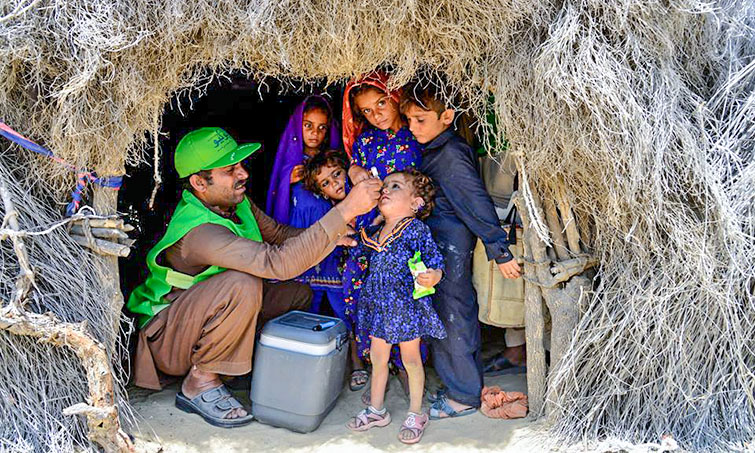
By Wasif Mahmood
Bhai Khan, Choolistan, Rahim Yar Khan – As the polio National Immunization Days (NID) begins, Muhammad Irfan, a dispenser, riding on a small jeep, makes his way into this small settlement comprising of shrub canopies in village Bhai Khan, Choolistan desert, some 70 kilometres off Rahim Yar Khan city.
“Any children under five living here”, fatigued and heavily perspiring Irfan enquires from one of the elders standing by a canopy. “Yes”, the elder replies after a little pause, adding: “there are 12 with us”. Overjoyed that his visit to the settlement has been fruitful, Irfan reclines on a charpoy offered by one of the elders in a canopy, checks yellow routine immunization cards and administers drops to all the children. After making sure that all children have been vaccinated he begs permission to leave. Instead he is served with tea made of camel milk.
Muhammad Irfan is on a routine mission in the desert to vaccinate children in the scattered settlements of the desert spread over 300 square kilometres against the vaccine preventable diseases including polio. He is one of the thousands of the frontline polio workers who go door-to-door to vaccinate children under-five all over the country. His unorthodox approach to vaccinate children, however, sets him apart from his peers.
During the NID, unlike others, he embarks on a week-long mission to Choolistan and never returns until he has vaccinated all children. He shares special bond with the community because he not only vaccinates children against polio but other vaccine preventable diseases.
Life in the desert is hard by lack of health facilities and acute water shortages affecting thousands of children living there with families. Rains and weather determine pattern of population movement in Choolistan and it is almost impossible to keep track of children who are more susceptible to polio due to poor conditions they live in and frequent movement.
“These communities keep changing their location and build their settlements around taubas (water ponds). To keep track of them, I maintain a list of the elders of various castes that are found here who give me valuable information of families with children”, says Irfan.
“Choolistan shares border with Dherki and Kashmore districts of Sindh where communities mostly migrate to the desert when rains dry up. With the ongoing circulation of poliovirus in Sindh’s districts, vaccination of these children holds key to saving their lives”, explains Irfan, a father of three who holds a diploma in vaccination.
Not long ago, all the communities were averse to any kind of vaccination. Irfan has been successful in convincing the communities to vaccinate children. With his support, the district health department is planning to prepare a map of ponds where all such families settle down with their children”, says Furqan Tahir, the District Health Communication Support Officer (DHCSO).
Punjab has made rapid progress towards eliminating polio from the province. In 2015, just two children suffered from polio paralysis and one of them belonged to Rahim Yar Khan. However, south Punjab districts including Rahim Yar Khan, as well as Lahore and Rawalpindi pose major challenge in the efforts to eliminate polio due to presence of migratory populations and hard to reach areas.
“Pakistan has never been so close to eradiation as it is now. The fight against polio is largely indebted to the selfless frontline health workers who work in difficult terrains. The number of cases is lowest ever, but we have to keep the pressure on virus”, says Dr. Faisal Zahoor, Director General of Health.
With the goal of ending polio in Pakistan is in sight, Government’s commitment to the implementation of NEAP via focused Emergency Operations Centres (EOCs) at national and provincial levels has been the driving force behind the recent progress. The last cases that came from the core reservoirs – were in Karachi and Khyber-Peshawar in early 2016, and from Quetta Block the last case was in December 2016. In addition, since September 2016, outbreaks have been effectively contained. Consequently, the number of children paralysed by the wild poliovirus has dropped from 3016 in 2014 to 54 in 2015 to 20 in 2016 and only two cases so far in 2017.
Hot weather in the desert and scattered nature of the dwellings along with the lack of health facilities and remoteness of Choolistan makes the task challenging to vaccinate every single child. However, we are making all effort to reach out to and meet the requirements of the population”, says Dr Munir Ahmad, EOC Coordinator who also holds the portfolio of director of Expanded Programme on Immunization in Punjab.
“Engaging with populations living in the desert may put one’s life at risk. But the risk of polio to children is even greater. With this fear in mind I plan my mission to Choolistan every campaign. I ensure the virus does not come back and affect any child again”, says Irfan reaffirming his commitment.
